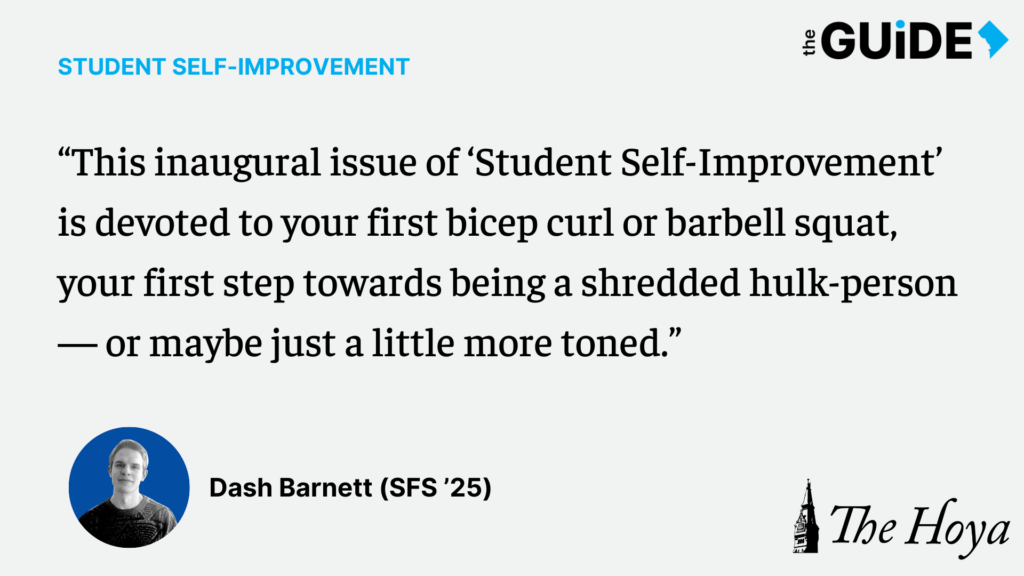On Jan. 1, 2023, private gym chain Equinox refused to accept new members.
“We don’t speak January,” they said. “You are not a New Year’s resolution.”
Luckily, Georgetown students can tell those $200-a-month snobs to shove it: Yates is always taking new members, and it only costs $40,000 a semester. If you’re among the millions of Americans who made a resolution to exercise more this year, we campus gym regulars would love to have you. This new, inaugural issue of “Student Self-Improvement” is devoted to your bicep curl or barbell squat, your first step towards being a shredded hulk-like person — or maybe just a little more toned. I do “speak January,” and I’d love to talk to you about it.
For the purposes of this article, we’ll assume you’re going to lift some weights for the first time. Maybe the person of your dreams cheated on you. Maybe you need to be big and strong in the face of declining U.S. hegemony. Maybe you have crippling self-image issues. Maybe you’ve seen innumerable studies listing exercise as an effective treatment for depression. Who knows? Frankly, it’s just kind of nice to be jacked.
First, let’s talk about programs. Most lifters’ goals boil down to strength, muscle size and slimming. You’re going to get all three from an average workout, but you’ll also want to cater your routine toward your goals. This routine is your recipe.
When you walk into the gym, water in hand, death metal in ears, you should have a plan for each workout. This will be divided into reps (individual movements) and sets (groups of reps). If you’re looking for strength, you’re going to go for a low number, generally 4-6 repetitions of the exercise. If you’re looking for size, you’re going to go for high reps, generally 8-12. As for sets, three is a solid starting place, and you usually don’t want more than five.
In between those sets, you’re going to want to rest — and the length of your rest also depends on your goals. Rest longer for strength goals, and rest for shorter periods of time if your goal is for size or slimming.
If this already sounds complicated, just stick with me while we choose exercises. The basic principle here is dividing your body into muscle groups and then choosing which day to work out in which group. For a beginner, the Official Student Self-Improvement Column Recommendation is to look up a solid push-pull legs routine online and begin with that regimen.
When you’re new to lifting, your body is going to respond well to any routine because it’s not used to intense muscle stimuli. You can do the worst program ever and you’ll still see results, but over time you want to settle into a solid routine tailored to your specific body. As I said, your routine is a recipe. You’ll have to Google “omelet recipe” the first couple of times you make one, but after a while, you get to know how much salt you like, what spices you want to mix in and at what texture your eggs taste best. Your body is unique and wonderful in its own way, and your routine should reflect that.
With the basics out of the way, we can discuss nutrition and supplementation. In general, you want to have carbohydrates before a workout and protein after a workout. Carbs will give your body the energy it needs to lift, and protein will feed your muscles afterward. You can supplement protein with protein powder, protein shakes or protein bars, but you don’t need to: the average (non-vegetarian) meal will contain plenty of protein.
You’ll also need to take a hard look at your other habits. Muscles grow and strengthen between workouts, not during them. Binge drinking or poor sleeping habits will heavily impair this recovery process. Most importantly, don’t take steroids unless you’re a professional bodybuilder or have some emotional attachment to dying at 45 with negative testosterone levels.
All this advice aside, the most important thing is just starting somewhere. Lifting is fun, it is oh-so-good for you and there are few experiences comparable to making yourself visibly better through hard work. Prove those Equinox jerks wrong for me, and stay tuned for the next issue of “Student Self-Improvement,” where we’ll discuss the pros, cons and methods of journaling.
Dash Barnett is a sophomore in the SFS. Student Self-Improvement will appear online and in print every other week.














